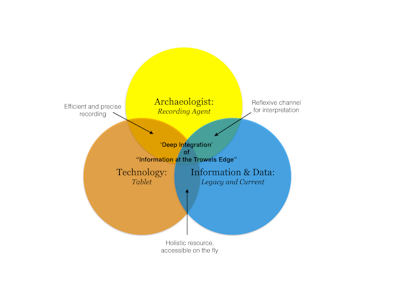
Generally, in its adoption of the tablet technology and the associated suite of software outlined in this article, the ÇRP has not encountered any problems that have been technically insurmountable. This paper has shown that aside from a degree of speed and efficiency in the recording process achieved through the construction of plans using the tablets, the tablet and on-board GIS can be seen as a hub for the 'deep integration' of 'information at the trowel's edge'. As such it effectively brings that part of the archive which is generally conceived of as being accessible 'off-site' (or perhaps even only accessible post-excavation) 'on-site', transforming the archive from a static reference knowledge-base to a dynamic interpretative tool in its own right. The reflexive, collaborative and 'bottom-up' nature of the development of the project's GIS and its constant refinement ('tuning') means it can be argued that the technology in this case has been 'bent' by the archaeological practice in the same way archaeological practice has had to adapt to the implementation of the GIS on site.
In this way the knowledge-creation process begins truly to fit into the recursive reflexive loop at a more fundamental level. Furthermore, the reflexive feedback loop itself could also be understood as being part of, or the same as, the normal continuous procedure used in the development of digital methods; a circuit of creating, using, modifying, using, tuning, versioning systems, etc. (à la Pickering 1995). If we choose to see the reflexive method as being deeply integrated within archaeological research in the same way as the further development of applied digital applications, we might ultimately conclude that using these instruments are less a methodological addendum to facilitate reflexivity, and more a quasi-embedded extension of the reflexive method itself, actually integral to its practice. The relationships between the 'Archaeologist', this 'Technology' and the process of 'Knowledge Creation' is represented in this concept of 'Deep Integration' (synthesised in Figure 17).

The critical and reflexive investigation of the digital recording practices developed by the ÇRP can inform broader disciplinary discussions in archaeology and beyond. The tensions in the developmental processes outlined in this article, that culminate in the notion of 'Deep Integration' by the adoption of digital technology in the field, reflect a wider dichotomy that has long haunted the social sciences (see for example Zubrow 2006, 1). On the one hand it can be argued that there is no need to talk about a 'digital archaeology' because technology and digital methods are simply tools that fit within a larger field of practice. In this sense the whole notion of 'digital' archaeology is a misnomer, since the machines and instruments that constitute a digital archaeology are simply a product of scientific practice, representing a work of cultural extension born from, or engendered by, that field of practice. On the other hand, by contrast it might be argued that the adoption of digital methods actually completely transforms archaeological methods, practice and culture, to the point where it truly merits the moniker 'Digital Archaeology' (in direct contrast to 'Traditional' or 'Analogue Archaeology' for example).
In fact what we would suggest, in trying to evaluate the way in which technology has been designed and implemented by the ÇRP, is that by incorporating Pickering's (1995) framework of real-time analysis of recording practices, and taking machine-agency and its interaction with human-agency into consideration, we end up with a third, far more nuanced understanding which allows us to move beyond this dichotomy by situating the use of digital tools within the broader development of the discipline. Surely, the digital approaches adopted at Çatalhöyük have been born from a field of practice that emulates the earlier analogue methods of the project, but the process of their development turns out to be a dialectic as it also transforms that same field of practice from which it comes. This relationship is dynamic and flexible.
Internet Archaeology is an open access journal based in the Department of Archaeology, University of York. Except where otherwise noted, content from this work may be used under the terms of the Creative Commons Attribution 3.0 (CC BY) Unported licence, which permits unrestricted use, distribution, and reproduction in any medium, provided that attribution to the author(s), the title of the work, the Internet Archaeology journal and the relevant URL/DOI are given.
Terms and Conditions | Legal Statements | Privacy Policy | Cookies Policy | Citing Internet Archaeology
Internet Archaeology content is preserved for the long term with the Archaeology Data Service. Help sustain and support open access publication by donating to our Open Access Archaeology Fund.